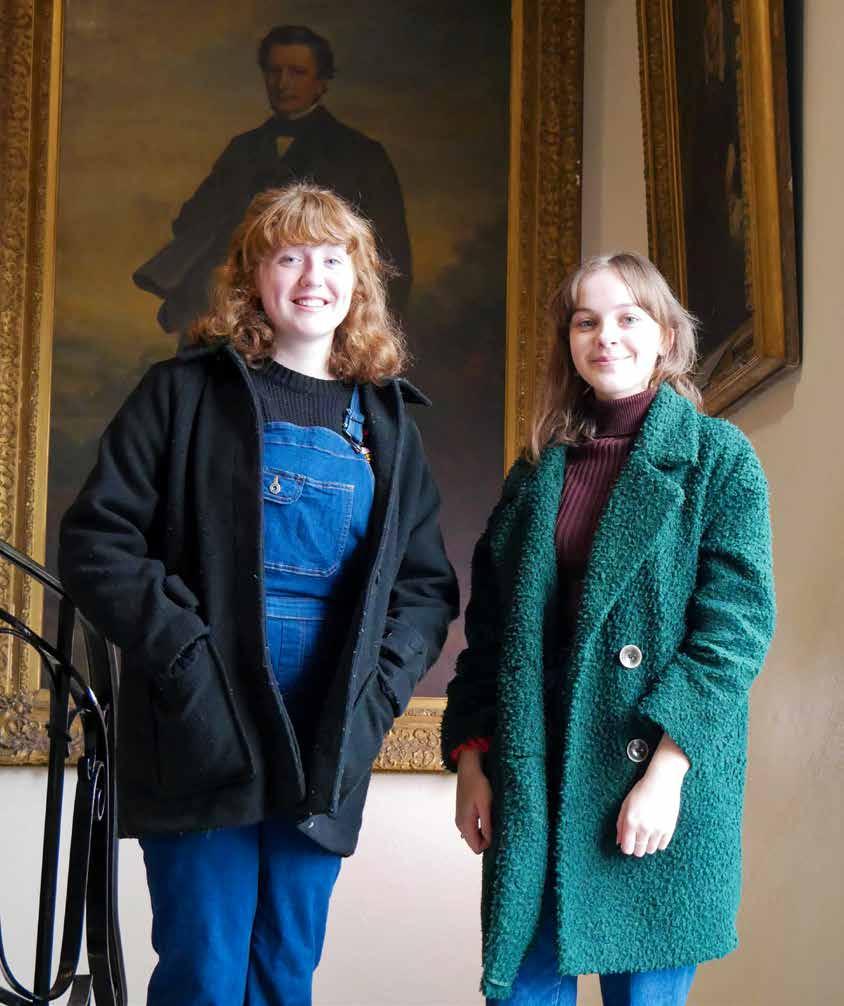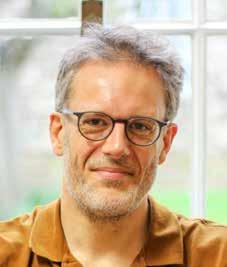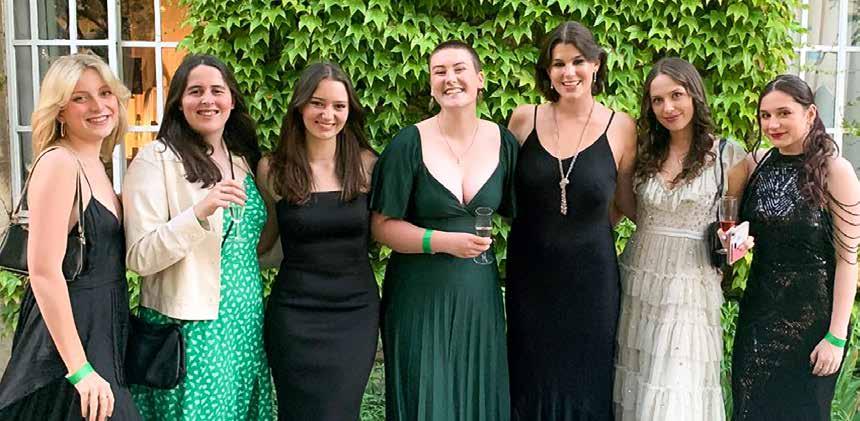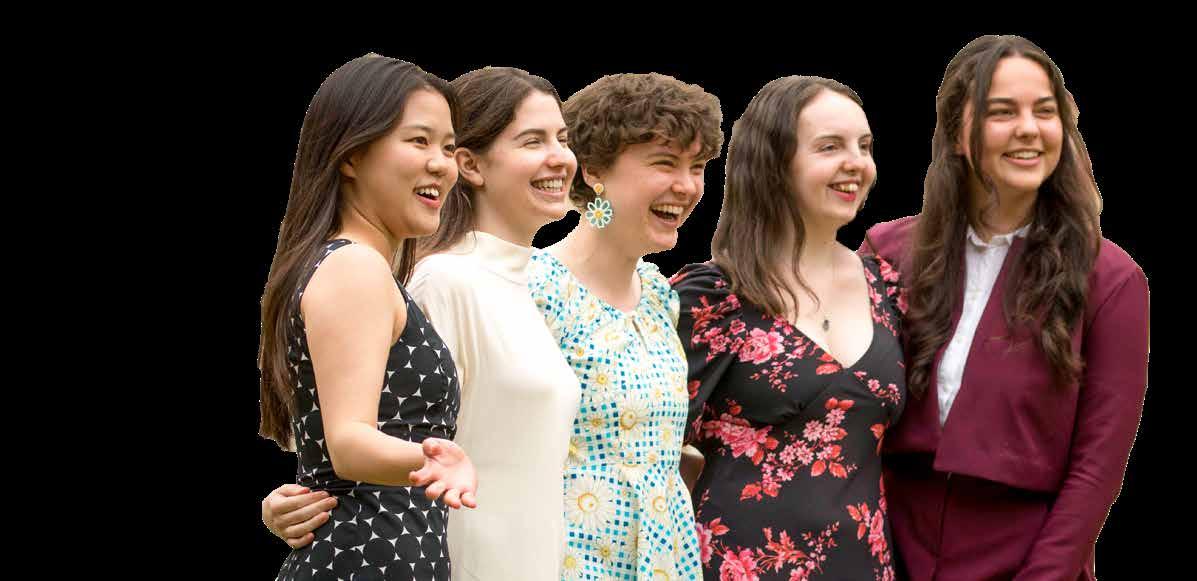
7 minute read
Reframing our past: An update on the portraits project
Dr Leif Dixon

Advertisement
Regent’s was a hive of energy and activity quite uncharacteristic for 9th and 10th week of Trinity, when we were privileged to host, and feel revivified by, a gang of almost implausibly enthusiastic researchers, joining us to help unlock the lived realities behind the impassive faces of our college portraits. As readers of last year’s edition of Regent’s Now will recall, we have decided to shed some fresh light on our collection, both to provide helpful contextualisations of the portraits for those who want to know more about those being commemorated, and to give us valuable knowledge that will help us to make informed decisions about who might adorn our walls in the future.
The central question is this – are the faces on our walls monuments to times past, or signifiers of our values today? In last year’s article, I suggested that the wider societal debate has become unhelpfully polarised, and that it makes almost as little sense to say that we should only commemorate those who share our modern values (even if they have been dead for several hundred years), as to claim that the past lies beyond interpretation and should be remembered unmediated, exclusively on its own terms (an ostensibly ‘historically-minded’ viewpoint that has the disadvantage of being shared by no professional historians). My sense from talking with colleagues and students was that there was a broad consensus that we wanted neither to engage in unthinking hagiography nor present-centric judgementalism; but more than that, what we wanted was clarity about who was being commemorated and why. There is a fundamental ethical difference between housing a statue of a historical figure in a museum and having them standing proudly uncontextualised in a public space – in the first case, the message being communicated is that the individual is of historical interest, while in the second the strong implication is that their life is being in some sense celebrated. Both have their place, but the problem comes when the lines get blurred. For instance, nobody would object to items relating to Jimmy Savile being carefully contextualised in an appropriate museum (for instance the Crime Museum at New Scotland Yard), whereas the citizens of Glasgow were more than reasonable in demanding that a statue of the disgraced paedophile be removed from a local leisure centre in 2012.
Central to an ethically-informed approach to historical commemoration, therefore, are two questions. First, who exactly is being commemorated? And second, why are they being displayed where they are? The question ‘why’ is important and urgent, but it is difficult to answer in abstract isolation. More foundational is the acquisition of knowledge about the faces behind the portraits. And this is where our intrepid researchers come in!
We secured our volunteers via the University Careers Service’s ‘microinternships programme’, an excellent scheme which allows current students to gain experience by working on college and departmental projects that interest them. We were extremely impressed both by the quality and the diversity of the candidates, ranging widely as they did across ethnicities, genders, degree subjects, and spanning first year undergraduates right the way through to DPhil candidates. It was a genuine privilege working with our volunteers on this project – their boundless enthusiasm, willingness to work in a self-directed manner, and their nuanced approach to the material impressed me no end. Usually at the end of Trinity I have no greater desire in the world than to go and lie down in a darkened room until people start considering whether to file a missing person report, but it was in fact simply a pleasure to be in college for these two weeks, chatting to the students every day over coffee about their discoveries and interpretative dilemmas. I need few reminders of why I love being a tutor – but what can sometimes get lost, simply for absence of opportunity, is the sheer pleasure of chatting to students outside the confines of the tutorial and (in my case) about something other than the reformation or civil wars!
A great deal of work got done. Of the over 40 portraits in the college collection, research on 23 was completed, including almost all of those in the dining hall. In order to help the interns feel truly invested in the project, I asked them not only to create a full set of biographical notes for each of their subjects, but also to write their own commemorative plaque of around 200 to 300 words – not only a very useful exercise in condensing their research down to its most significant elements, and a way of getting us off to a running start when we come to finalise the contextual information that will accompany each portrait, but also a small offer of immortality to the interns themselves, whose findings and words will make up a significant element of what will eventually go up on our walls.
Our aim was to do justice to the historical figures whose portraits we possess. But doing justice is a two-way street, and involves critical scrutiny of both the positives and negatives. In some cases, we were able to bring to light moments of principle and courage in dark and difficult days – as when Melbourn Evans Aubrey, the General Secretary of the Baptist Union, made the decision to condemn the Baptist churches of Germany for their silence over Nazi atrocities in 1937, declaring that ‘we [English Baptists] have our own tradition of protest against every form of tyranny.’ At other times, it was possible to compare the attitudes of portrait subjects to each other in productive ways – for instance, it could have been assumed that Henry Wheeler Robinson’s decision to refuse to fund the exam fees of the college’s first female student, Violet Hedger, was merely reflective of 1920s social assumptions; except that the preceding principal, George Pearce Gould, had actively championed Violet’s cause. Information about this episode will be recorded on all three portraits, and cross-referenced so that viewers can make up their own minds.
At times we also had the opportunity to accent diversity which had once been pushed firmly into the background. Perhaps the best example of this is a portrait in the dining hall titled simply ‘William Carey, 1761-1834.’ It does not require a perceptive viewer, though, to notice that there are two people in the portrait – a foregrounded white man gazing profoundly into the middle distance, and a (curiously pallid) Indian man looking respectfully at the back of his head. That Indian man was Mrityunjay Vidyalankar, an extraordinary linguist and scholar, without whom Carey simply would not have been able to translate the Bible into six Indian languages. This is now a portrait of Carey and Vidyalankar. The intern’s write-up also makes clear, though, that for all that two men are now being recognised equally, there is also a woman who is not being represented at all. This is William’s wife, Dorothy, who uprooted her entire life to accompany her husband to India, and ended up sacrificing her own mental health to facilitate his sense of mission. As our intern firmly and beautifully put it, first quoting a contemporary biographer of William Carey’s: ‘“Somewhere in missionary history, a word of compassion should be written for Dorothy Carey, who paid a high price for the
Baptist missions”; and that somewhere is contained within this plaque.’
This is just a small taster of the ways in which we have been seeking to do justice to the subjects of our portraits, and to show sensitive engagement with their lives and achievements, while also opening up some of the wider contexts which may have been ignored, and giving recognition to those whose voices and experiences may have been forgotten. We intend to run a final round of micro-internships this coming Easter, and from there we will be in a position to create a full set of biographical plaques, and set about giving our collection a shape fit for the twenty-first century.
Michaelmas term began with Freshers’ Week, in which we welcomed the new members of college and brought the Regent’s community together with a range of group activities. The third years who missed out on their half-way hall attended a ‘two-thirds’ hall, allowing them to celebrate their accomplishment as a year group. At the same time, social events in college were back up and running with the return of bops, cheese and wine nights, and movie nights.
In 7th week, as we entered the Advent period, the JCR welcomed two Regent’s Park alumni: the writers of the HBO/ BBC series Industry. Their talk was exceptionally engaging and inspiring. By the final week of term, Christmas festivities were in full swing, with carols, Christmas tree decorating, a Christmas themed bop and brews, the JCR pantomime, and Secret Santa.
We began Hilary term with a ‘British icons’ themed bop. The return of Regent’s famous Burns night made for a fantastic evening, bringing the SCR, MCR, and JCR together to celebrate in true Regent’s fashion. The second years celebrated hitting the halfway mark of their degrees with a formal and social. The offer-holders’ open day went successfully, with tours, lunch, Q+As, and refreshments. The third years invited their parents to a formal hall for the last time before entering their final term.
Trinity was an excitingly busy term for the JCR. The Regent’s Garden Play returned, with a very successful performance of Comedy of Errors, selling 120 tickets and raising £390 for Meningitis Now. Manny’s yearly birthday party also raised money for Meningitis


Now and was a special occasion for the whole community. Other traditional end of year events such as Finalist Formal and Valedictory celebrated the achievements of those who were graduating. We also recognised the successes of many Regent’s students within the wider University, including those in sport, music, drama, and publishing, with the Recognition Formal at which alumna and author Hazel Barkworth gave the address. The year ended with a spectacular evening with our first Final Fling since 2019, with huge thanks to the Final Fling committee. It was a real success and, after the disruptions of the pandemic, the perfect way to bring the Regent’s community together.
Charlotte Baxendale was President of the Junior Common Room (20212022) and an undergraduate student reading for the BA in Theology and Religion (2020).
We have also held some lovely welfare events through the terms including mug decorating and distributing snacks and kind messages to cheer people up. The bar was redecorated, gaining a new lease of life and enhancing its popularity on a university wide level. It has been a wonderful year of events, social activities, and college achievements. I would like to thank Rosie and the previous executive committee for a successful start to the year. I am especially grateful to my executive committee and officers for making these past three terms so enjoyable at Regent’s. Finally, thank you to the Fellows and the SCR for supporting us in all that we have done this year.





